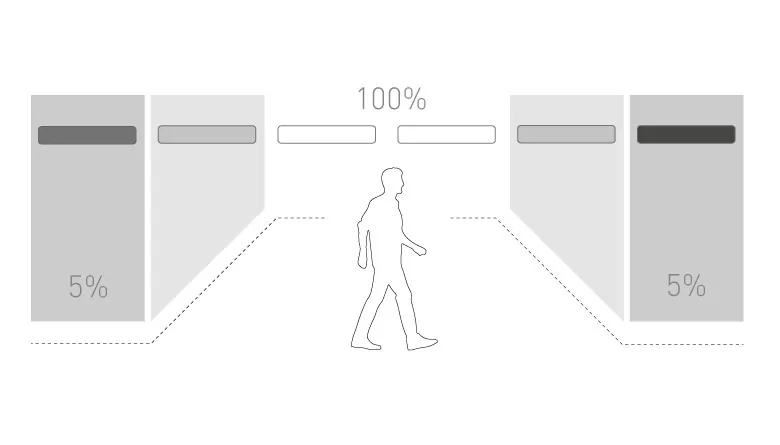Corridor function
Corridor function refers to controlling lighting based on whether motion has been detected.
This is achieved by connecting a regular motion detector to the ballast (with a relay, no triak). Combining the use of such a sensor and the function of the ballast makes it possible to control a single fixture or an entire set of luminaires. Light intensity increases when a person enters the room. When the person has left, the motion detector is set to turn off with a delay, resulting in an automatic reduction of light intensity.

Corridor function refers to controlling lighting based on whether motion has been detected.
This is achieved by connecting a regular motion detector to the ballast (with a relay, no triak). Combining the use of such a sensor and the function of the ballast makes it possible to control a single fixture or an entire set of luminaires. Light intensity increases when a person enters the room. When the person has left, the motion detector is set to turn off with a delay, resulting in an automatic reduction of light intensity.
Corridor function is a perfect choice for spaces that require permanent illumination due to security reasons. These include e.g. public buildings, extensive residential complexes, parking houses and lots, pedestrian underpasses and underground railway stations. Light intensity in such spaces is normally low but increases if more light is required.
LED drivers feature a variety of profiles, allowing them to provide the best output under a range of conditions. It is necessary to have the LED driver programmed in order to set the corridor function. Alternatively, a lighting control system may be used to change the parameters.
Profiles are defined by a variety of values (corridor mode):

- Attack time: time that starts to run once occupancy has been detected. Light intensity increases during this period of time until it reaches the occupancy value (default 0,7s to 100%).
- Start time: time that starts to run once occupancy is no longer detected (120s). If a person occupying the space is detected during this period of time, start time is reset and starts to run again from zero. If no occupancy is detected during attack time, reduction time will be triggered.
- Reduction time: period of time during which light intensity is reduced from occupancy value to non-occupancy value (default 32s from 100% to 10%).
- Turn-off delay time: period of time for which non-occupancy value is maintained. Turn-off delay time may vary based on the profile selected or it may remain undefined (never turns off).
- Non-occupancy value: light intensity when no person occupies the space (default 10%).
- Occupancy value: light intensity when one or more persons occupy the space (default 100%).
A user may choose to opt for a digital signal controller (DSI or DALI) anytime without having to replace the luminaire or provide additional control lines.
MERRYTEK MC030S E occupancy sensor: a settings example
It is possible to set sensor data precisely for every application by selecting a combination of DIP switch variables.
DIP Switch settings
Recognition area (sensitivity)
| 1 | 2 | 3 | ||
| I | ON | ON | ON | 100% |
| II | - | ON | ON | 75% |
| III | ON | - | ON | 50% |
| IV | - | - | ON | 25% |
| V | - | - | ON | 25% |
Activation time
| 4 | 5 | 6 | ||
| I | ON | ON | ON | 5s |
| II | - | ON | ON | 30s |
| III | ON | - | ON | 90s |
| IV | - | - | ON | 3 min |
| V | ON | ON | - | 20 min |
| VI | - | - | - | 30 min |
Daylight threshold
| 7 | 8 | 9 | ||
| I | ON | ON | ON | 2 Lux |
| II | ON | ON | - | 10 Lux |
| III | - | ON | - | 25 Lux |
| IV | ON | - | - | 50 Lux |
| V | - | - | - | *Disabled |
*Disabled means daylight sensor is out of order. Once motion has been detected, the switch turns on the fixture regardless of the light intensity of the surroundings.